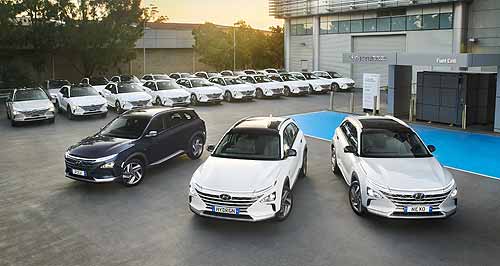News - Market Insight - Market Insight 2021Market Insight: Green shoots of hydrogen appearNew era: The arrival of FCEV vehicles in Australia will continue the gradual shift away from ICE cars. Hyundai’s H2 vehicle starts a new genre as petrol gradually falls from favour9 Mar 2021 By NEIL DOWLING HYDROGEN has made its first appearance on the national vehicle sales list as Hyundai last month road-registered the country’s first fuel-cell vehicle.
It is a small step in the alternative fuel journey precipitated by the avalanche of legislation accompanying a move away from fossil-fuels for transport.
The 20 Nexo hydrogen fuel-cell cars now wearing NSW license plates may be as significant as the 112 electric vehicles registered in 2010 by fleet operators as a precursor to the now-accepted list of EVs on the market, as shown by VFacts sales data.
EVs are certainly coming and likely to be an unstoppable force that could perhaps equate to the SUV invasion.
But it’s happening quietly, just like the way LPG vehicles disappeared from the VFacts list – a sole entry was made in 2017 before exiting, possibly forever – to be replaced by PHEVs (plug-in hybrid electric vehicles).
There are notable trends in our choice of vehicles based on fuel or power source. Diesel, for example, has slid after plateauing from 2012 through to 2016 but is now down at levels previously seen around 2009.
The same slide is visible with petrol, predominantly as buyers move away from traditional sedan cars and also because of the downward vehicle sales market over the past three years. Petrol-vehicle sales are now below 2009.
No surprise that much of the attention has been taken up by hybrids. Hybrid sales were around 4200 in 2009 and flattened from 2012 (with 13,919 sales) through to 2018 (14,328 sales).
From then, new products and an expanding fleet market that included taxis that pushed heavily for Toyota Camry Hybrids, rocketed 2019 sales to 31,191 units and then almost doubling to 60,419 in 2020.
That hybrid leap was accentuated by vehicles led by the Toyota RAV4, but also including eight other models in the Toyota portfolio, along with the Hyundai Ioniq, various Lexus models, and Subaru Forester and XV.
Toyota actually shocked the market and more than brought the hybrid concept into most Australian lounge rooms with the RAV4 becoming Australia’s most popular car in August last year, selling 4405 units that month.
It was not only a win for hybrids but it was the first time an SUV had become the nation’s most popular vehicle.
For Toyota, the 4405 RAV4 hybrid sales represented a record 91.3 per cent of total RAV4 sales in August 2020, against 420 petrol versions.
The possibilities are likely with EVs and perhaps the timeline will be quicker, if not for the uptake of buyers but because of the potential availability of new EV models in Australia.
In 2015, EVs accounted for only 0.12 per cent of the passenger car and SUV sales in Australia (note: data does not include Tesla that doesn’t share sales figures, so the actual number and percentage will be higher).
In 2020, despite a market size that had fallen 150,000 units, EVs picked their percentage up to 0.26 per cent. That is not big by any stretch – meaning 1755 sales – but it has doubled its market in five years.
Hybrids, on the other hand, have scored better. They lifted their market share from 1.3 per cent of the car and SUV sectors in 2015, to 8.9 per cent in 2020.
The acceptance of alternatives has also lifted the shares of PHEVs, with their first appearance as a separate class in 2019 with 1426 sales, predominantly Mitsubishi Outlanders.
By 2020, there were other PHEVs including the Hyundai Ioniq, Ford Escape, Mini Countryman, Mercedes A250e, C300e, E300e and GLC300e; Volvo XC40 Recharge, XC60 and XC90; BMW 330e, 530e, 745e, X5 45e; Range Rover Sport P400e; and the Porsche Cayenne and Panamera.
Meanwhile, in the past decade petrol-fuelled cars and SUVs fell from 85.6 per cent of the market to 75.6 per cent (2009-2020). Despite concerns about diesel fuel, diesel actually lifted their percentage because of the continuing rise of SUV sales. Diesel has a 14.9 per cent share of this sector in 2020, up from 12.9 per cent in 2009.
Now it could be hydrogen’s turn. Hyundai registered 20 Nexo fuel-cell SUVs in February but these are for a private fleet involved in the ACT government’s Hornsdale wind farm project.
No more Nexos are expected until late this year or early 2022, in line with the building of infrastructure to fuel the vehicles. There is one site in NSW and more are planned for Melbourne and Brisbane, then expanded to locations in NSW, South Australia, Western Australia and Tasmania.
It’s just the beginning.  Read more1st of March 2021  Market Insight: JLR prepares for electrificationJaguar and Land Rover divide over future tech while parent company suffers upheavals |
Click to shareMarket Insight articlesResearch Market Insight Motor industry news |


















Facebook Twitter Instagram